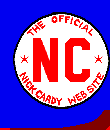 |
 |
 |
 |
 |
 |
 |
 |
 |
         |
||
|
Nick Cardy
In the 1950's, as Nick Cardy, he drew the Tarzan comic strip and later worked for DC National Comics drawing 2 short lived series, The Legends of Daniel Boone and the jungle adventure, Congo Bill and stories for varied titles including House of Mystery and Gang Busters. For Standard Comics, he drew many horror and romance comics. Following those series, Cardy enjoyed a long tenure drawing 40+ issues of Aquaman, where he designed Mera and Ocean Master. With Carmine Infantino becoming publisher of DC Comics, Cardy gained more creative freedom which was most evident on the Aquaman covers. Cardy also handled most of the artwork (drawing and/or inking) for the first 42 issues of the Teen Titans among other comics stories. As the Teen Titans grew into adulthood, Cardy designed Wonder Girl's new look. On the cover of Teen Titans 23, Wonder Girl's sandals and pigtail were replaced by beads, boots and a new hairdo. Back off, tigers!! Along with the Teen Titans, Cardy found time to draw the short lived western series, Bat Lash. Even today, the combination of great stories, beautiful women and cartoonish villains makes Bat Lash a cult favorite. Cardy wrote as well as drew Bat Lash 2. After the Teen Titans, Cardy worked on Marvel Comics' Crazy Magazine and was the primary cover artist for DC from the early to mid 1970's. Cardy drew many, many covers including Superman, Action Comics, The Brave and the Bold, Batman, Flash, Ghosts, Witching Hour, Secret Origins, Jimmy Olsen, World's Finest and the various 100 Page Giant comics. During the late 1960's, Nick helped childhood friend, Al Plastino on the Batman syndicated strip. After finally leaving comics, Cardy moved on to illustrating advertising art and movie posters. Cardy worked on posters for "Apocalypse Now", "Movie, Movie", "California Suite", "The Street Fighter", "The Night They Robbed Big Bertha's", and "Casey's Shadow". Today, Cardy is retired, but still draws very well. Throughout his comics career, Cardy always handled the penciling and inking of the artwork. This is unique, occasionally during the 1950's and even more in the 1960's, artwork was usually divided between an artist who started the art in pencil and another artist who completed the art in ink. Although his drawing style has changed over the years, Cardy has consistently delivered artwork featuring great composition, rendering and story telling. Cardy's renditions of gorgeous female characters became one aspect of his still singular drawing style. Cardy is one of the few comic artists who are as skilled at drawing western, jungle, crime and super-hero adventures as drawing romance, science fiction, humor and horror. Had Cardy been drawing Superman or Batman on a regular basis, he would be widely considered one of the greatest comic artists. In any case, Congo Bill, Aquaman and Teen Titans are some of the most sought after comics series. Although Nick Cardy is not as well known as some of his contemporaries, his artwork is respected and admired by those contemporaries. Cardy's cult following includes many of today's comic writers and artists. Find those Cardy comics and join the club! |
||
|
Gallery || Rare Cardy || Recreations || Q & A || Messages |
 Nicholas Viscardi worked in the Iger/Eisner studio doing Fight Comics,
Jungle Comics, Kaanga Comics for Fiction House.
For Will Eisner, Viscardi drew the Lady Luck strip in the Spirit newspaper sections.
Many Lady Luck stories by Chuck Mazoujian and Viscardi were credited to Ford Davis,
a fictional name. In her article in the Lady Luck volume 2 reprint book,
Cat Yronwode noted that somewhere in his stories Viscardi would have a subtle NV.
Nick Viscardi was the first artist to draw Senorita Rio, in Fight Comics 19.
Viscardi left comics to serve in World War II as a tank driver and was awarded
2 Purple Hearts.
Nicholas Viscardi worked in the Iger/Eisner studio doing Fight Comics,
Jungle Comics, Kaanga Comics for Fiction House.
For Will Eisner, Viscardi drew the Lady Luck strip in the Spirit newspaper sections.
Many Lady Luck stories by Chuck Mazoujian and Viscardi were credited to Ford Davis,
a fictional name. In her article in the Lady Luck volume 2 reprint book,
Cat Yronwode noted that somewhere in his stories Viscardi would have a subtle NV.
Nick Viscardi was the first artist to draw Senorita Rio, in Fight Comics 19.
Viscardi left comics to serve in World War II as a tank driver and was awarded
2 Purple Hearts.